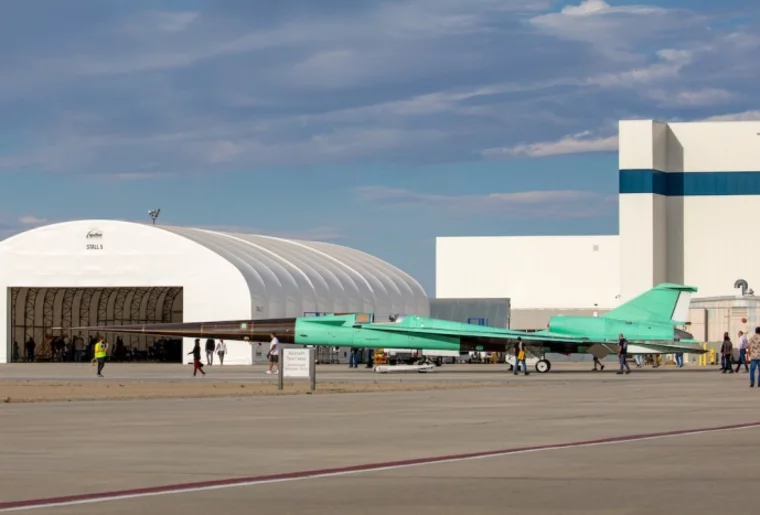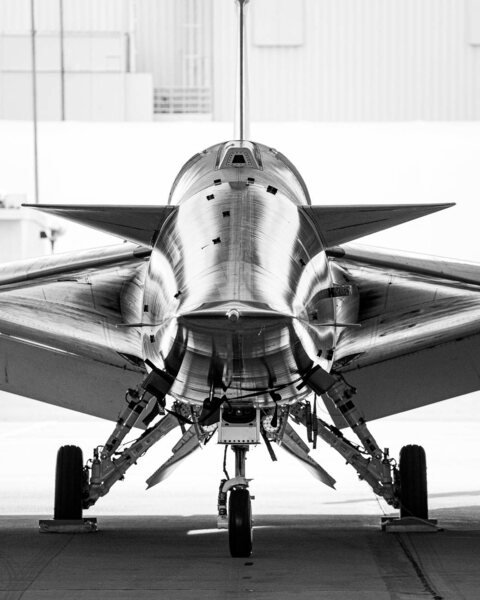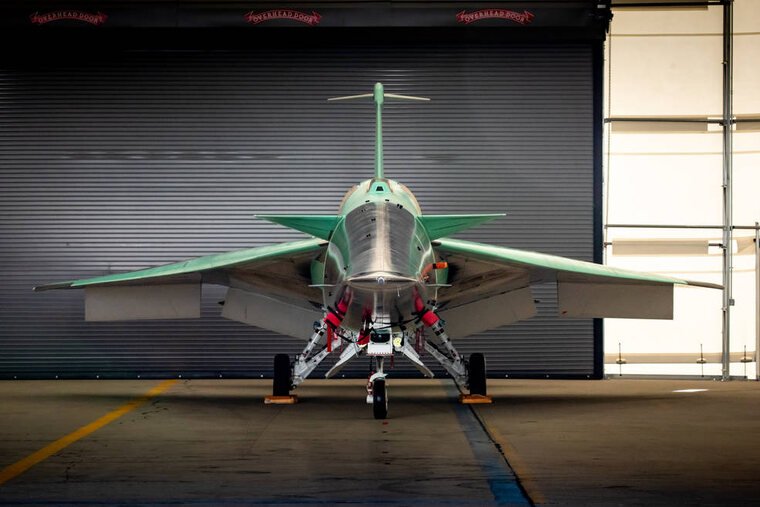NASA’s X-59 Quiet SuperSonic Technology (QueSST) aircraft is on the brink of its inaugural test flight scheduled for later this year.
Designed by Lockheed Martin’s illustrious and highly secretive advanced concepts division, Skunk Works, the X-59 lives up to its name by using cutting-edge technology to mitigate the thunderous sonic boom accompanying an aircraft breaking the sound barrier.
By reducing the deafening noise to a more subdued “sonic thump,” the X-59 has the potential to revolutionize commercial supersonic air travel, which has long been hindered by regulations governing noise pollution.


A recent series of images released by NASA showcases the X-59 stationed on the flight line at Lockheed Martin Skunk Works in Palmdale, California.
“This transition from the construction site to the flight line is just one among several key milestones in preparing the X-59 for its initial and subsequent flights,” NASA said in a press release. The team’s next priority is to conduct various crucial ground tests, affirming that the aircraft is thoroughly prepared for its maiden voyage.
Lockheed Martin secured a preliminary design contract from NASA in February 2016, with initial plans to achieve flight readiness by 2020. A 9% scale model was subjected to wind tunnel testing in early 2017, encompassing speeds ranging from Mach 0.3 to Mach 1.6. In the fall of 2017, after passing a preliminary design review, NASA awarded Lockheed Martin a contract valued at $247.5 million for designing, constructing, and delivering the “low-boom” X-59.
When an aircraft is in motion, it generates a series of pressure waves in front and behind, much like the waves created by a boat’s movement through the water. These pressure waves travel at the speed of sound, but as the aircraft accelerates, the waves become compressed, eventually converging into a single shock wave.
The sudden change in air pressure caused by the shock wave results in an intense acoustic disturbance, perceived as a sonic boom on the ground. The boom is characterized by a sharp, explosive sound, often likened to an explosion or loud thunderclap.
The magnitude of a sonic boom depends on various factors, including the size and shape of the aircraft, its altitude, and the atmospheric conditions. Typically this thunderous applause of nature measures around 110 decibels and can carry enough sound energy to break windows of buildings on the ground. For this reason, restrictions have been placed on supersonic flights over land.
While Lockheed Skunk Works has been working on constructing the X-59, NASA has been gathering data on the noise pollution associated with sonic booms.
In late 2018, America’s space agency conducted a series of research flights involving the generation of up to eight sonic booms a day at various locations. The booms were monitored by a network of 20 noise sensors, while the experiences and perceptions of 400 residents were captured and documented. A F/A-18 Hornet was used to simulate the sonic booms, with the aircraft diving 50,000 ft and allowing it to briefly attain supersonic speeds, thereby reducing shock waves.
X-59 QueSST measures 94 ft in length, with a wingspan of 29.5 ft (9.0 m) and a maximum takeoff weight of 32,300 lb (14,700 kg) and is powered by a General Electric F414 engine, providing a thrust of 22,000 lbs with afterburner activation. The cockpit, ejection seat, and canopy of the X-59 are derived from a Northrop T-38, while the landing gear originates from an F-16.
The X-59 is projected to achieve a maximum speed of Mach 1.5 or 990 mph and a cruising speed of Mach 1.42 or 940 mph at an altitude of 55,000 ft (16,800 m).
The X-59’s groundbreaking design incorporates a long, slender airframe and canards to mitigate the shockwaves’ convergence, thereby minimizing ground noise.
The sonic boom from the X-59 is anticipated to reach approximately 60 dB, roughly 1/1000th the loudness of current supersonic aircraft. Consequently, the jet is projected to generate a 75 Perceived Level decibel (PLdB) thump, comparable to the sound of closing a car door.
The X-59’s long and pointed nose cone obstructs all forward vision, so instead of a conventional cockpit, a pilot uses the Collins EVS-3600 multispectral imaging system, beneath the nose, for landing. The NASA External Vision System (XVS), in front of the cockpit, gives a forward view of the aircraft.
This revolutionary synthetic monitoring system was showcased in the fictional “Darkstar” hypersonic aircraft built by Lockheed Martin Skunk Works for the film Top Gun: Maverick.


One of the forthcoming test flights later this year will involve supersonic travel by the X-59 over multiple communities, allowing NASA to gauge residents’ responses to the sonic thump generated during high-speed flight.
Subsequently, NASA intends to share its findings with U.S. and international regulatory bodies, potentially paving the way for commercial supersonic flights over land.
There are several examples of supersonic commercial aircraft, most notably the Concorde, jointly developed and operated by British Airways and Air France.
Operating for over 27 years, the Concorde could traverse the Atlantic Ocean in about three and a half hours, significantly reducing travel times between continents. However, high operating costs and an unfortunate accident involving Air France Flight 4590 in 2000 resulted in the Concorde eventually being retired in 2003.
Sonic booms are the most significant obstacle to commercial supersonic flight’s long-term viability. Because of noise pollution issues and regulatory limitations, supersonic flights are almost exclusively limited to overwater flight paths. However, this could all change if the X-59 successfully reduces sonic booms to a dull sonic thump.
The X-59’s target cruising altitude of 55,000 feet and a speed of Mach 1.42 (937 mph) is nearly double the velocity of current conventional passenger jets, offering the potential to reduce flight times between destinations dramatically. For example, a journey between New York City and Los Angeles, presently lasting around 5.5 hours, could be shortened to approximately 2 hours and 30 minutes or even less.
Ultimately, NASA and Lockheed Martin believe the X-59 can enable new commercial cargo and passenger markets in faster-than-sound air travel across the United States and worldwide.
Tim McMillan is a retired law enforcement executive, investigative reporter and co-founder of The Debrief. His writing typically focuses on defense, national security, the Intelligence Community and topics related to psychology. You can follow Tim on Twitter: @LtTimMcMillan. Tim can be reached by email: tim@thedebrief.org or through encrypted email: LtTimMcMillan@protonmail.com

